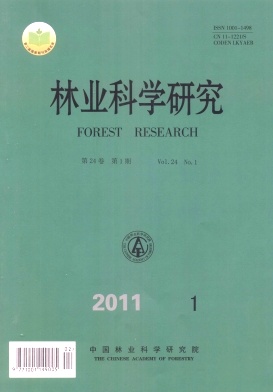|
[1]
|
International Expert Consultation on Non-Wood Forest Products. Report of the International Expert Consultation on Non-Wood Forest Products:Yogyakarta, Indonesia[M].Rome: Food and Agriculture Organization of the United Nations , 1995:17-27 |
|
[2]
|
谢志忠,杨建州,黄晓玲,等.非木材林产品可持续利用与乡村社会林业的协调发展[J].科技和产业,2006,6(5):5-8
|
|
[3]
|
关百钧.发展非木材林产品保护天然林[J].林业科技通讯,1999(1):39-40
|
|
[4]
|
冯彩云.世界非木质林产品现状、存在问题及其应对政策[J].林业科技管理,2001(2):56-59
|
|
[5]
|
关百钧.世界非木材林产品发展战略[J].世界林业研究,1999,12(2):1-6
|
|
[6]
|
Ticktin T. The ecological implications of harvesting non-timber forest products[J]. J Ecol, 2004, 41: 11-21 |
|
[7]
|
Freed J. Non-timber forest products in local economies: the case of Mason County, Washington[J]. J Sust Forest, 2001, 13(3-4): 67-69 |
|
[8]
|
Ticktin T, Nantel P. Dynamics of harvested populations of the tropical understory herb Aechmea magdalenaein old-growth versus secondary forests[J]. Biol Conserv, 2004, 120: 461-470 |
|
[9]
|
张爱美,谢 屹,温亚利,等. 我国非木质林产品开发利用现状及对策研究[J]. 北京林业大学学报:社会科学版,2008,7(3):47-51
|
|
[10]
|
李西林,周秀佳,南艺蕾.中药濒危药用动植物资源保护与可持续利用[J].上海中医药大学学报,2006(6):69-77
|
|
[11]
|
王 琦. 墨西哥的非木质林产品[J].世界农业,1993(10):40-42
|
|
[12]
|
McCormack A. Guidelines for inventorying non-timber forest products .Oxford,1998:127 |
|
[13]
|
纪 萍,申世斌,闫恩维. 浅析林副特产学科与科技期刊[J].中国林副特产,2000(2):63-64
|
|
[14]
|
左 停.关于社区林业实践中技术层面的若干问题[J].林业与社会,2002(1):3-7
|
|
[15]
|
曾燕如,潘继进,喻卫武.国际森林认证与我国森林食品的生产[J].浙江林学院学报,2004,21(4):480-485
|
|
[16]
|
段红莲,蔺汝涛. 对高黎贡山自然保护区开展非木质林产品利用现状调查的思考[J]. 林业调查规划,2004,29 (3):46-49
|
|
[17]
|
王国梁.林副产品资源资产评估[J].四川林业勘察设计,1996(1):12-14
|
|
[18]
|
Wickens G E. Management issues for development of non-timber forest products. Unasylva[J] .1991,42(165): 3-8 |
|
[19]
|
Tilling A J. Realising the potential of non-timber forest products: the predicament of West Coast indigenous forest-based users in the South Island, New Zealand[J]. Journal of World Forest Resource Management, 1994,7(2):129-50 |
|
[20]
|
Gregersen H M, Arnold J E M, Lundgren A L, et al.Valuing forests. Context, issues and guidelines . FAO Forestry Paper 127, Rome, 1995 |
|
[21]
|
Townson I M. Incomes from non-timber forest products: Patterns of enterprise activity in the forest zone of southern Ghana . ODA, London, 1995 |
|
[22]
|
Warner K. Marketing, valuation and pricing of NWFPs. [M]// Durst P, Bishop A. Beyond Timber: Social, Economic and Culturaldimensions of Non-wood Forest Products in Asia and the Pacific. FAO, Bangkok, Thailand,1995:97-108 |
|
[23]
|
Taylor F, Mateke S M, Butterworth K J. 1996 A holistic approach to the domestication and commercialization of non-timber forest products[M]// Leakey R R B, Temu A B , Elnyk M, et al. Domestication and Commercialization of Non-timber Forest Products in Agroforestry Systems, Non-Wood Forest Products 9. FAO, Rome, 1996:75-85 |
|
[24]
|
代正福,周正邦.贵州亚热带地区野生经济植物资源调查及评价[J].贵州农业科学,2000,28(4):48-51
|
|
[25]
|
淮虎银,付文竹.非木材林产品的民族植物学研究进展[J].植物资源与环境学报,2006,15(3):65-72
|
|
[26]
|
李建平,林 喆,邓明鲁.中国动物药概况[J].中药研究与信息,2003,5(8):24-27
|
|
[27]
|
刘正祥,张华新,刘 涛.我国森林食品资源及其开发利用现状[J].世界林业研究,2006,19(1):58-65
|
|
[28]
|
楼炉焕,王彩霞,王 慧.果实类型分类探讨[J].浙江林学院学报,1998,15(1):85-90
|
|
[29]
|
中国林学会.林副特产的采集培育和利用[M].北京:中国林业出版社,1983
|
|
[30]
|
邹积丰,韩联生,王 瑛.非木树林产品资源国内外开发利用的现状、发展趋势与瞻望[J].中国林副特产,2000(1):35-38
|





 DownLoad:
DownLoad: